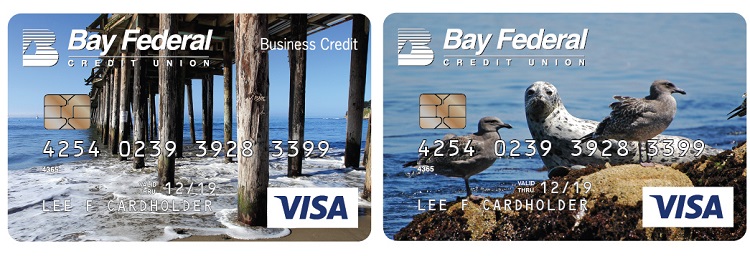Top-Level Takeaways
-
Bay Federal uses a single processor for debit and credit for faster speed to market and stronger internal efficiencies.
-
Data analytics are also better than siloed systems and allow for better-targeted marketing.
The word convert comes from the Latin con and vertere, which means to turn. Bay Federal Credit Union ($935.3M, Capitola, CA) was aiming to turn things around when it simultaneously converted its debit and credit processing platforms.
CU QUICK FACTS
Bay FCU
Data as of 12.31.17
HQ: Capitola, CA
ASSETS: $935.3M
MEMBERS: 69,916
BRANCHES: 6
12-MO SHARE GROWTH: 10.3%
12-MO LOAN GROWTH: 6.5%
ROA: 0.91%
Bay Federal had been using separate vendors for its debit and credit programs but, with an eye toward greater efficiencies and deeper member relationships, converted to Visa DPS for both in 2017. The process made heads spin for a while, but since then transaction activity in existing products is up and the credit union is ahead of budget in interchange income.
Here, Cameron Haste, executive vice president and chief operating officer at the six-branch, 70,000-member institution, shares why the credit union saw the conversion as an opportunity to increase internal efficiencies, how it can better act on member data, and what results its has noted to date.
ContentMiddleAd
When and why did Bay Federal decide to convert its debit and credit card programs?
Cameron Haste: We made the decision on Feb. 2, 2016, and went live on Feb. 27, 2017.

Cameron Haste, EVP, Bay Federal Credit Union
Strategically, we were focused on streamlining processes and increasing efficiencies, and this conversion enabled us to migrate to a single processor. Also, a card program is a cornerstone to a member’s PFI relationship, and we needed a vendor partner that could help us improve our program. The new reporting tools help with data mining and analysis.
Find your next partner in Callahan’s online Buyer’s Guide. Browse hundreds of supplier profiles by name, keyword, or service area.
Describe the conversion process and the resulting program structure.
CH: This conversion was the credit union’s primary project for 2017. The process was intense and involved numerous major projects that resulted in a single processor for ATMs, EMV chipcards, online credit card processing, digital wallets, and an app that includes card on/off and geo location functions. The simultaneous conversion of debit, credit, and ATM was taxing on the organization.
What interfaces did you need to address and how did you handle that; for example, between your core and with other third-party add-ons to your card services?
CH: VISA DPS facilitated weekly project meetings that all our third-party processors attended. Obtaining support and alignment with interface partners was a key success factor to the conversion. Interfaces included Fiserv DNA, instant issue, card plastic production, and ATM image processing.
Who was on the project team?
CH: We had an enterprise project manager, but this was an organization-wide effort that involved cross-functional partners ― card services, accounting, deposit and lending teams, technology, facilities, branches, etc.
Take 5
Cameron Haste, EVP and COO at Bay Federal, shares five ways to take the pain out of a card processor conversion.
- Include all vendor partners and interfaces in project team meetings.
- Ensure that internal resources have the availability and commitment to support the project.
- Include all cross-functional partners from the beginning and overcommunicate to keep all parties employees and members informed.
- Ensure that all project team members are open to collaboration and invested in the process.
- Include all vendors on regularly scheduled, frequent calls to keep messaging timely and consistent and address issues efficiently.
What kind of internal messaging did you provide around the project?
CH: We provided weekly communications about the project status through our company newsletter. Also, we invited staff to participate in the pilot testing. Our focus was on constant training and awareness that resulted in excitement for the project.
Please describe your member messaging around the conversion.
CH: We kept our members apprised of what we were pursuing and the benefits they’d receive, such as increased security. We needed to share why they couldn’t keep their old cards and how they could mitigate the impacts of these changes, such as automatic payments for gym memberships.
We reached out to members and let them know how they could help us, such as ensuring we had accurate contact information and addresses. It was a cool collaboration between the credit union and its membership.
What kind of special staffing did you need, if any, especially for the go-live date?
CH: The contact center was fully staffed, and we assigned some float staff to the department during the conversion. Our branch staff was also ready to provide support when the contact center needed it.

On the left is a Business Credit account credit card from Bay Federal Credit Union. The card on the right is for Bay Federal Classic credit card account holders.
How did the go-live process go?
CH: It was as smooth as a rollout of that size could go. We needed to make some minor adjustments, but overall, it was extremely successful. We’re proud our CEO didn’t receive any escalated calls relating to the conversation.
Talk about the results of the conversion.
CH: We’ve noted a marked increase in transaction activity in our existing products.
The conversion created the foundation for our credit union to relaunch and re-energize our card program, and in the coming year, we’ll focus on improving our card offering to the membership.
We were 19% ahead of budget in interchange income early in 2018. This is the direct result of increased card usage, post card conversion.
What improvements have you made in workflow processes, data storage, and analytics?
CH: Going through the conversion enabled our organization to transition to best practices. The change process itself was made easier by the fact that none of the systems were the same.
Charge-off, exception, balancing, and reporting processes are a lot easier and more efficient now because we have a single processor.
Also, our campaign management tools now come directly from the processor. This was a huge time savings. We already have the information to segment and target the appropriate cardholders.
This interview has been edited and condensed.
